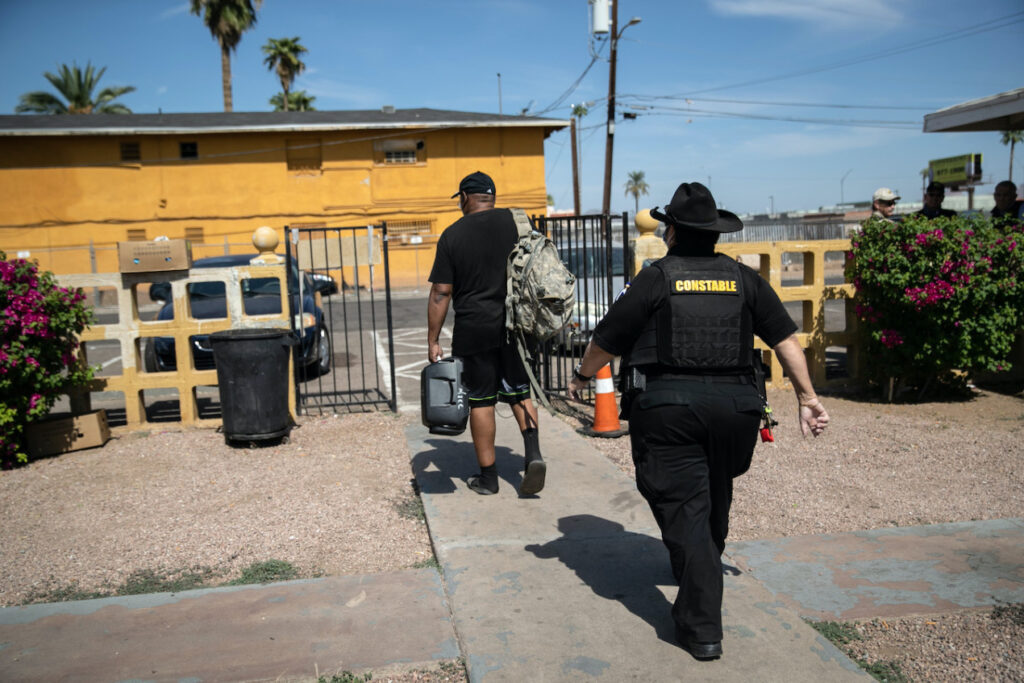The life expectancy of Hispanics and African Americans has suffered the worst decline since World War II
10 min read
Although James Toussaint has never had covid, the pandemic is deeply affecting his health.
First, in the spring of 2020, the 57-year-old lost his job delivering parts for a New Orleans car dealership when the local economy froze. Then he fell behind on his rent. Last month, Toussaint had to leave his apartment when the landlord, who refused to accept federally funded rental assistance , found a legal hole in the federal ban on evictions .
Toussaint has had trouble controlling his blood pressure. With arthritis in his back and knees, he cannot lift more than 20 pounds, a major obstacle to his work.
You are concerned about what will happen when your unemployment benefits that were awarded for the pandemic run out, which could happen on July 31 .
“I’ve been homeless before,” said Toussaint, who was able to rent a room nearby after his eviction. “I don’t want to be homeless again.”
With coronavirus infections falling in the country, many people are eager to leave the pandemic behind. But it has caused wounds that do not heal easily . In addition to killing 600,000 people in the United States and affecting an estimated 3.4 million or more with persistent symptoms , the pandemic threatens the health of vulnerable people devastated by the loss of jobs , homes and future opportunities .
It will almost certainly cast a long shadow over American health, causing millions of people to live sicker and die younger due to rising rates of poverty , hunger and housing insecurity .
In particular, it will exacerbate the discrepancies that have already been seen in the country between the wealth and health of black Americans and Hispanic Americans (who can be of any race), and those of white Americans.
In fact, new research published in the journal BMJ shows just how big that gap has become. Life expectancy across the country plummeted by nearly two years between 2018 and 2020, the biggest decline since 1943, when American soldiers died in World War II, according to the research.
But while white Americans lost 1.36 years, black Americans lost 3.25 years and Hispanic Americans lost 3.88 years. Since life expectancy typically varies only a month or two from year to year, losses of this magnitude are “quite catastrophic,” explained Dr. Steven Woolf, a professor at Virginia Commonwealth University and lead author of the study.
During the two years included in the study, the average loss of life expectancy in the country was almost nine times greater than the average in 16 other developed nations, whose residents can now expect to live 4.7 years longer than Americans. Compared to their peers in other countries during this period, Americans not only died in greater numbers but at a younger age.
The country’s death rate soared almost 23% in 2020, when there were roughly 522,000 more deaths than there would be in a normal year. Not all of these deaths were directly attributable to covid-19. The heart attack death and stroke increased in 2020, partly driven by the delay in treatment or lack of access to medical care, Woolf said.
More than 40% of Americans postponed treatment during the first months of the pandemic, when hospitals were packed, and just entering a medical facility seemed risky. Without immediate medical attention, heart attacks can cause congestive heart failure; delaying treatment for stroke increases the risk of long-term disability.
Much of the devastating public health impact during the pandemic can be attributed to economic disparity. Although stock prices have rebounded from last year’s slump, reaching record highs, many people continue to suffer financially , especially African Americans and Hispanic Americans .
In a February report , economics analysts at McKinsey & Co. predicted that, on average, black and Hispanic workers will not regain their pre-pandemic jobs and wages until 2024. And the lowest paid employees with no high school education perhaps nor do they recover by then.
Although federal and state aid programs have cushioned the impact of job losses from the pandemic, 11.3% of Americans today live in poverty, compared with 10.7% in January 2020 . A federal moratorium on evictions, which has helped approximately 2.2 million people remain in their homes, expires on June 30.
Without protection against evictions, “millions of Americans could fall into an abyss,” said Vangela Wade, president and CEO of the Mississippi Justice Center, a nonprofit advocacy group.
Eviction erodes a person’s health in multiple ways. “Poverty causes a lot of cancer and chronic disease , and this pandemic has caused a lot more poverty, ” said Dr. Otis Brawley, a Johns Hopkins University professor who studies health disparities. “The effect of this pandemic on chronic diseases, such as cardiovascular disease and diabetes, will be measured in the coming decades.”
Twenty million adults have recently had trouble putting food on the table. Not being able to afford healthy foods , which are generally more expensive than salty and processed foods, can cause harm in both the short and long term. For example, people with low incomes are more likely to be hospitalized for low blood sugar towards the end of the month, when they run out of money to buy food.
In the long term, food insecurity is associated with an increased risk of diabetes , high cholesterol , hypertension , depression , anxiety, and other chronic diseases , especially in children .
“Once the acute phase of this crisis has passed, we will face a huge wave of death and disability,” said Dr. Robert Califf, former Commissioner of the Food and Drug Administration (FDA), who wrote about health risks. following a pandemic in an April editorial in the medical journal Circulation . “These will be the other consequences of Covid.”
Less wealth, worse health
American health was poor even before the pandemic: 60% of the population suffered from a chronic condition , such as obesity, diabetes, hypertension or heart failure. These four conditions were associated with nearly two-thirds of COVID hospitalizations, according to a February study in the Journal of the American Heart Association .
Deaths from some chronic diseases began to rise among low-income Americans in the 1990s, Woolf said. That trend was exacerbated by the Great Recession of 2007-09, which undermined the health not only of those who lost their homes or jobs, but also the general population .
However, the Great Recession and its health effects did not affect all Americans equally. Black people control less wealth today than before the recession, while the gap in financial security between black and white Americans has widened, according to a Nonprofit Quarterly article published last year. And the unemployment rate among black workers didn’t rebound to pre-recession levels until 2016.
Researchers have developed a better understanding in recent years of how chronic stress , caused by poverty, job loss, and homelessness, leads to illness. Relentless stress causes inflammation that can damage blood vessels, the heart, and other organs.
Research shows that people with low incomes live an average of seven to eight years less than those with financial security. The richest 1% of Americans live almost 15 years longer than the poorest 1%.
Poor people tend to smoke more; are at increased risk for chronic diseases such as cardiovascular disease, diabetes, kidney disease, and mental disorders; and they are more likely to be victims of violence.
The stress of the pandemic has also led many people to smoke, drink and gain weight, increasing the risk of chronic diseases. Fatal drug overdoses increased 30% between October 2019 and October 2020.
Jennifer Drury, 40, has battled substance abuse, particularly prescription painkillers, since she was 20. She blames the isolation and stress of the pandemic for a relapse and losing friends to overdoses.
“Downtime is not good for addiction,” said Drury, who fell behind on her rent and was evicted from her previous home. She said smugglers are never far away, especially at the New Orleans motel where she now lives with her husband. “Drug traffickers don’t care about pandemics.”
Women losing ground
The American Rescue Plan , which provides $ 1.9 billion in pandemic relief, was designed to help displaced workers and cut child poverty rates in half. The real benefits of the law may be less extensive.
Twenty-five states have chosen to eliminate additional federal unemployment payments , citing concerns that these generous benefits pay people more to stay at home than they can earn working.
Many women say that they would like to go back to work but have no one to take care of their children. Almost half of the child care centers have closed and others have reduced the number of children they serve.
The Federal Reserve Bank of Minneapolis concluded that “economic recovery depends on the availability of child care.” A March report from the National Center for Women’s Law estimates that “women have lost a generation of gains in labor force participation,” which could leave them and their children financially disadvantaged for years.
Ruth Bermúdez is one of the millions of women who left the workforce last year. Bermúdez, who was laid off from her job as a behavioral health social worker in New Orleans, said her childcare needs have prevented her from finding work. Taking care of her 6-year-old daughter became her full-time job after the pandemic closed schools.
Although her daughter has returned to classes, Bermúdez said school closings due to the covid outbreaks have been frequent and unpredictable.
“I had to be a teacher, make lunch, drive, all at the same time,” said Bermúdez, 27. “It is exhausting”.
Life-changing evictions
James Toussaint had only two weeks to find a new place to live after a judge ordered his eviction. He couldn’t be with his family.
“I have family, but they all have problems of their own,” said Toussaint, who had to throw away all his clothes and furniture because they had become infested with bed bugs. “Everyone is doing everything they can to help themselves.”
Toussaint now rents a room in a boardinghouse without a kitchen and a shared bathroom for $ 160 a week. She had to buy cleaning supplies with her own money to disinfect the bathroom, which she said is often unusable because of how dirty it is.
Sharing common space is often unhealthy and increases the risk of being exposed to the coronavirus, said Emily Benfer, a visiting professor at Wake Forest University School of Law. Even moving in with family presents risks, he said, because it is impossible to isolate or quarantine him in crowded homes.
Benfer co-wrote a November study that found that covid infection rates grew twice as high in states that lifted moratoriums on evictions, compared to states that continued to ban them. Roughly 14% of renters have fallen behind on their rent, double the rate before the pandemic.
Toussaint’s annual lease expired during the pandemic, so he had to rent month-to-month. While some states require landlords to show “good cause” for eviction, Louisiana landlords can evict tenants for any reason after their annual rental agreement has expired.
Property owners have filed for more than 378,000 evictions during the pandemic in just the five states and 29 cities tracked by the Princeton University Evictions Laboratory. A growing body of evidence shows that eviction is toxic to health and causes immediate and long-term damage that increases the risk of death.
Studies show that evicted people are more likely to have general health or mental health problems even years later .
“This singular event alters the course of life for the worse,” Benfer said. “If we don’t intervene” to prevent mass evictions when the moratorium ends, “it will be catastrophic for generations to come.”
Damages caused by eviction can be measured at all stages of life:
When pregnant women are evicted, their newborns are more likely to be premature or very young, and have a higher risk of dying in the first year of life . Women who are evicted are more likely to be sexually assaulted , Benfer said.
Children who are evicted are at a higher risk of lead poisoning in substandard housing, Benfer said. They are also more likely than others to be hospitalized.
Evicted adults report poorer mental health and are more likely to be hospitalized for a mental health crisis, studies show . They also have higher suicide mortality rates. Although the causes of addiction are complex, research shows that counties with higher eviction rates have significantly higher rates of drug- and alcohol-related deaths.
People who are evicted often move into substandard housing in neighborhoods with higher crime rates. These places are sometimes plagued with mold and roaches, underheated, or have non-working plumbing. Landlords have no incentive to make repairs to tenants who are behind on their rent, Benfer said. In fact, those who report dangers or ask for repairs run the risk of being evicted.
Although middle-class Americans take their kitchens for granted and depend on them to cook healthy meals, more than 1 million households lack full kitchens, according to the Census Bureau .
New Orleans does not require that rental units include stoves, said Hannah Adams, also an attorney for Southeast Louisiana Legal Services. Toussaint’s new room is equipped with a microwave and small refrigerator, but does not have a sink, oven, or stove. Wash the dinner dishes in the bathroom. His landlord does not allow residents to have electric ranges, so most of his meals include cold cereals, cold cuts sandwiches, or meals that he can heat in the microwave. His doctor has urged Toussaint, who is prediabetic, to lose weight, eat less salt, and quit smoking.
Toussaint, who lived on the street for two years, said he is determined not to return there. He hopes to apply for disability insurance, which would provide him with an income if his arthritis prevents him from finding a stable job.
Woolf said he hopes Americans will not forget the suffering of people like Toussaint as COVID cases decline.
“My concern is that people feel that the crisis is behind us and everything is fine,” Woolf said. His research, which connects four decades of economic opportunity with declining life expectancy, shows that “we are facing a big problem, and that was true before we knew a pandemic was coming.”
The pandemic does not have to condemn a generation of Americans to disease and premature death, said Dr. Richard Besser, president and CEO of the Robert Wood Johnson Foundation.
By addressing issues such as poverty, racial inequality, and a lack of affordable housing, the country can improve the health of Americans and reverse trends that have caused communities of color to suffer. “How the pandemic will affect people’s future health depends on what we do after this,” Besser said. “It will take an intentional effort to make up for the losses that have occurred over the past year.”
This article was originally posted on The life expectancy of Hispanics and African Americans has suffered the worst decline since World War II







